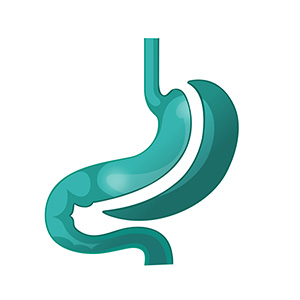Gastric Sleeve

Basic Information
-
Sleeve Gastrectomy (Gastric Sleeve) is the most commonly performed bariatric surgery.
-
Sleeve Gastrectomy leads to weight loss through a decreased appetite and reduction of stomach size.
-
Surgery is performed with keyhole techniques (laparoscopic) under a general anaesthetic.
-
Hospital stay is usually two nights.
The stomach is divided with staplers, creating a narrow tube. The larger part of the stomach is removed.


Gastric Sleeve Operation
Am I a candidate for weight loss surgery?


What is Sleeve Gastrectomy?
Sleeve Gastrectomy is performed using laparoscopic (keyhole) techniques to remove a large segment of the stomach (up to 80% of the total volume), whilst maintaining the normal passage of food anatomically. The remaining stomach looks very similar to a normal stomach, only much narrower.
The capacity of the stomach is reduced from about 1.5 litres of food and liquid to approximately 300mls. Feedback loops counteract hunger even when you have eaten very little. Severe hunger is reduced. Despite being smaller, the remaining stomach functions normally.
The surgery involves 4 to 5 small incisions in the abdomen, and dissection and stapling off of the excess stomach (which is removed from the body), using special stapling devices. Care is taken with the stapler to minimize the risk of leakage.
Prior to Surgery
You will need to be on an ‘Ultra-low Calorie Diet’ before surgery. Optifast is taken for 2 weeks to replace ALL meals. Your nutritionist will advise you on appropriate very low calorie substitutes to give you a break from the optifast (Salad or steamed vegetables without dressings or oil for a ‘treat’).
The usual stay in hospital is 2 post-operative nights.
Following Surgery
Day 2-7: Fluids that could be sucked through a thin straw.
Day 7 to week 3-4: Pureed food.
Week 4+: Slow introduction of some more solid foodstuffs thereafter, as guided by the team.
-
Progress from thin to thick only after the thinner fluids are easily tolerated
Reflux (heartburn) is occasionally experienced early after sleeve gastrectomy, you will therefore have an anti-acid tablet for 30 days. Sometimes it persists long-term and an anti-acid treatment might be required.
Potential Complications
This is the complication that worries bariatric surgeons the most with respect to this procedure. The leak is caused by a combination of the intentionally high pressure stomach and either a failure of staples or a failure of healing. Most leaks occur in the upper part of the staple line where the healing can be most compromised. Leaks could occur:
-
early (within days of surgery) while you are still in hospital, with peritonitis. You would need another keyhole surgery to washout and drain the infected fluids, and other procedures such as stents until it healed. This is very rare, particularly if you haven’t had stomach surgery before.
-
later (within weeks of surgery) when you are home recovering. The symptoms to particularly watch for are signs of infection like fever or sweats. These leaks would usually cause an abscess (localized collection of pus) around the upper stomach. These are usually managed with small plastic tubes (stents) placed by an endoscope.
There are some patient and surgical factors that influence the likelihood of a leak:
-
Previous surgery (particularly gastric band) due to the scar tissue build up and the possibility of folded over stomach in the staple line. This is thought to be particularly when the removal of band is performed at the same time as the sleeve operation.
-
Smoking impedes healing and there is some evidence that it might affect leak rates, so smokers should cease prior to surgery.
-
Too-tight sleeve. We know that as we tighten the remaining stomach by using smaller sizing tubes, we run into more problems from leak because of pressure.
-
Other technical aspects, such as type and size of staples, the use of buttressing, the presence of a sliding Hiatus Hernia, where the upper staple-line could be ‘sucked’ up into the negative pressure of the chest influence leak rates.
Preventing a leak: There is no absolute way to prevent a leak in Gastric Sleeve. Early leaks due to technical failure are very rare. Most leaks occur because of a healing problem and show up at around 2-6 weeks after surgery.
The risk of a leak: The overall risk of a leak is between 1-2%. Dr Crawford will explain if he thinks your risk is higher than this.
Many people have reflux before surgery from being overweight. Some have a Hiatus Hernia which is a weakness in the diaphragm, just above the stomach which is checked for and if necessary corrected during surgery. After surgery, around 30% will suffer some degree of reflux that might mean taking anti-acid tablets long term. For severe reflux a conversion to a bypass operation might be necessary (about 1/50 patients).
These include but are not limited to the following which are similar for almost any abdominal surgery.
-
Wound infection
-
Bleeding/Clots
-
Pneumonia
-
Heart trouble
-
Hernia
-
Bowel obstruction




